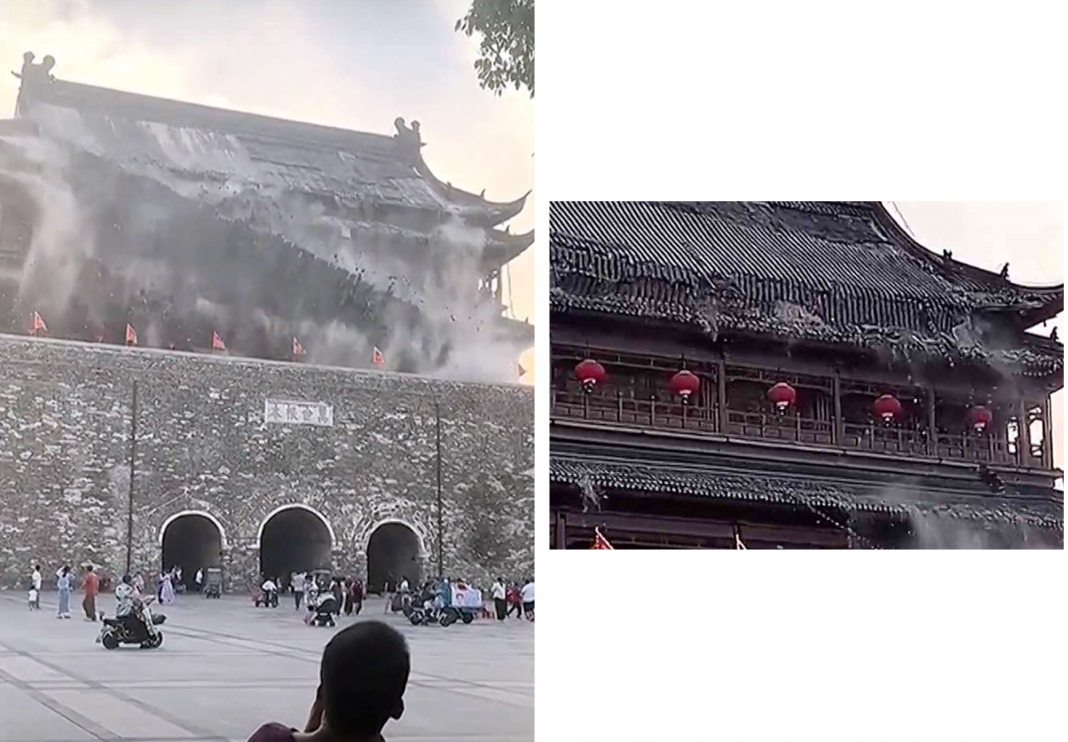In a startling moment that highlights the fragility of ancient structures, hundreds of roof tiles cascaded from a centuries-old tower in China, scattering startled tourists and prompting immediate investigations. Though no injuries were reported, the event raises fresh questions about the preservation of historical monuments.
A close call at a cultural landmark
What began as a regular sightseeing excursion at one of China’s historic landmarks turned into a scene of chaos as visitors to the Fengyang Drum Tower were caught off guard by a sudden collapse of roof tiles. The unexpected incident occurred when hundreds of traditional tiles slid off the roof of the 600-year-old structure, sending a thick cloud of dust into the air and sending tourists running for safety.
Captured on video, the dramatic fall saw debris tumbling roughly two stories to the ground below. According to eyewitness accounts and reports from the BBC, several tourists narrowly escaped being hit. “The tile falling lasted for a minute or two,” one witness recounted to Yangcheng Evening News, a state-backed newspaper.
Despite the intense scene, local authorities confirmed there were no injuries—a fortunate outcome considering the tower’s popularity and the number of visitors present. The swift response by on-site personnel and emergency services likely helped avoid a more tragic scenario. Officials from Fengyang County’s Culture and Tourism Bureau quickly cordoned off the area and evacuated bystanders as a precaution.
:max_bytes(150000):strip_icc():focal(563x389:565x391):format(webp)/Tiles-falling-off-tower-4-052125-a2d98dfd16a647d5b7ab97ac102e7c2a.jpg)
A tower steeped in history
The Fengyang Drum Tower is more than just a tourist attraction—it’s a symbol of the town’s deep historical roots. Originally constructed in 1375 during the Ming Dynasty, the tower has stood as a sentinel over the region for centuries. Drum towers like this one were traditionally used as both watchtowers and timekeeping structures, central to the rhythm of daily life in ancient Chinese settlements.
While the tower’s base is authentically Ming in origin, much of the superstructure is a more modern reconstruction. The original tower suffered extensive damage over the centuries due to weather, neglect, and war. In 1995, it was largely rebuilt in an effort to preserve its legacy. However, as the recent incident illustrates, even reconstructed heritage sites are not immune to the wear and tear of time.
Recent repairs had been carried out to address what officials described as “minor damage” to the roof. Whether those renovations contributed to or failed to prevent the recent collapse remains a key question in the ongoing investigation. As of now, the cause of the tile fall has not been publicly confirmed.
:max_bytes(150000):strip_icc():focal(520x394:522x396):format(webp)/Tiles-falling-off-tower-1-052125-d19bfc677a064c6e8b47009d654ebfcb.jpg)
Preservation vs. risk: The dilemma of heritage sites
The incident underscores a broader concern faced by countries rich in cultural heritage: how to preserve ancient architecture while ensuring public safety. In China alone, thousands of heritage sites dot the landscape, each presenting its own preservation challenges. The pressure is especially intense at tourist-heavy destinations, where foot traffic, environmental exposure, and maintenance limits combine to heighten the risk of structural failure. “The more visitors a site receives, the more wear it suffers,” said one cultural preservation expert familiar with Chinese historical sites. “Restoration is not just about aesthetics—it’s about safety.”
That delicate balance between maintaining authenticity and ensuring durability often pits traditional materials against modern engineering standards. Tile roofs, though beautiful and historically accurate, are especially vulnerable to shifting weather patterns, seismic activity, and age-related degradation. In some cases, preservation authorities must choose between replacing traditional materials with modern alternatives or risking further degradation.
For structures like the Fengyang Drum Tower, which hold both cultural and architectural significance, these decisions are not made lightly. The recent tile fall may well serve as a wake-up call to re-evaluate the structural integrity of similar heritage buildings across the country.
A temporary closure and a time for reflection
For now, the Fengyang Drum Tower is closed to the public as repairs commence and experts assess the full extent of the damage. County officials have launched an investigation into the cause of the collapse, while local conservationists urge for a comprehensive review of maintenance practices.
Though the tower will likely reopen once it’s deemed safe, the incident has left an indelible mark on both the community and the many tourists who witnessed it firsthand. It also brings renewed focus to the silent fragility of China’s ancient monuments—many of which continue to endure despite centuries of upheaval.
Whether the incident leads to broader policy changes in cultural preservation remains to be seen. But for now, it stands as a reminder that the past, no matter how carefully preserved, is never entirely safe from the pressures of the present.



